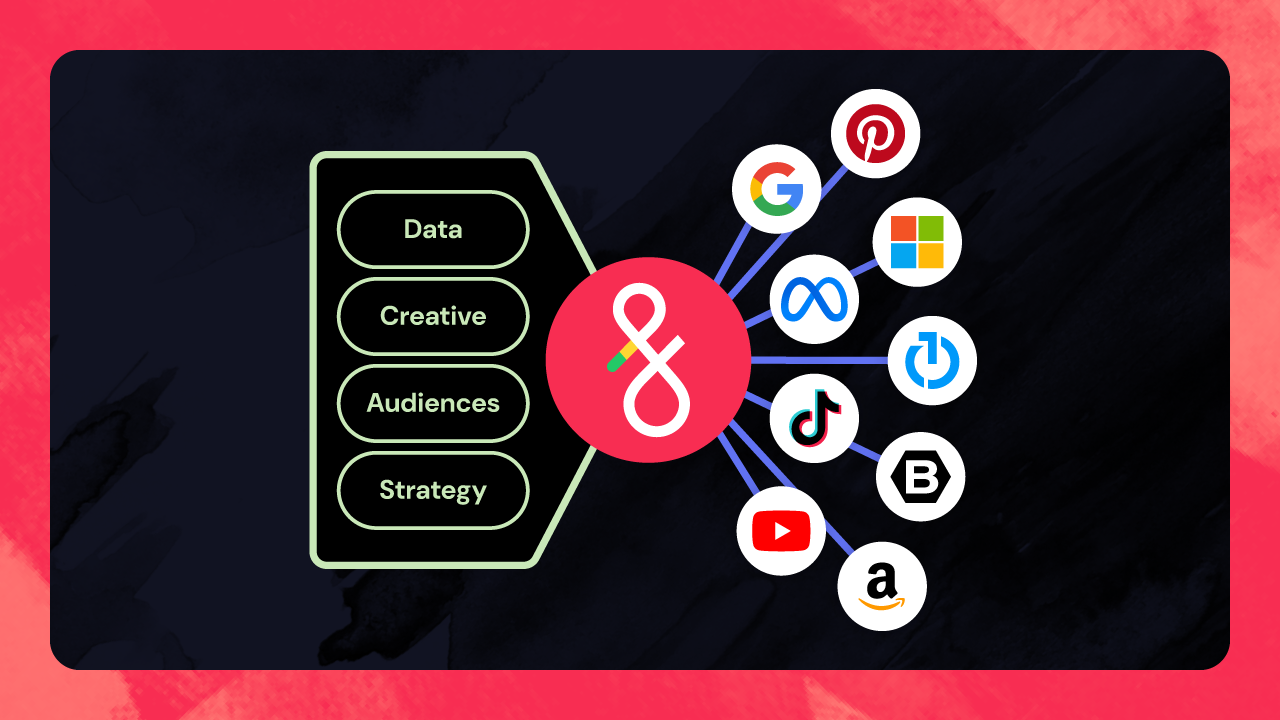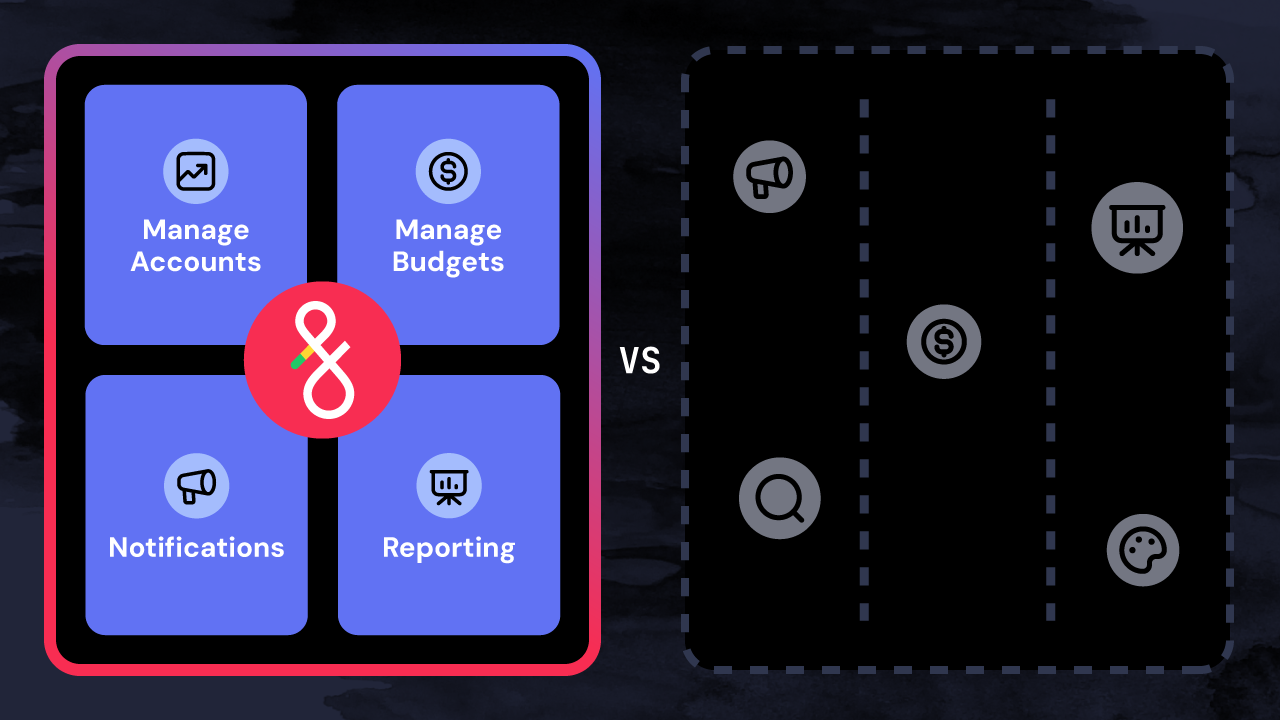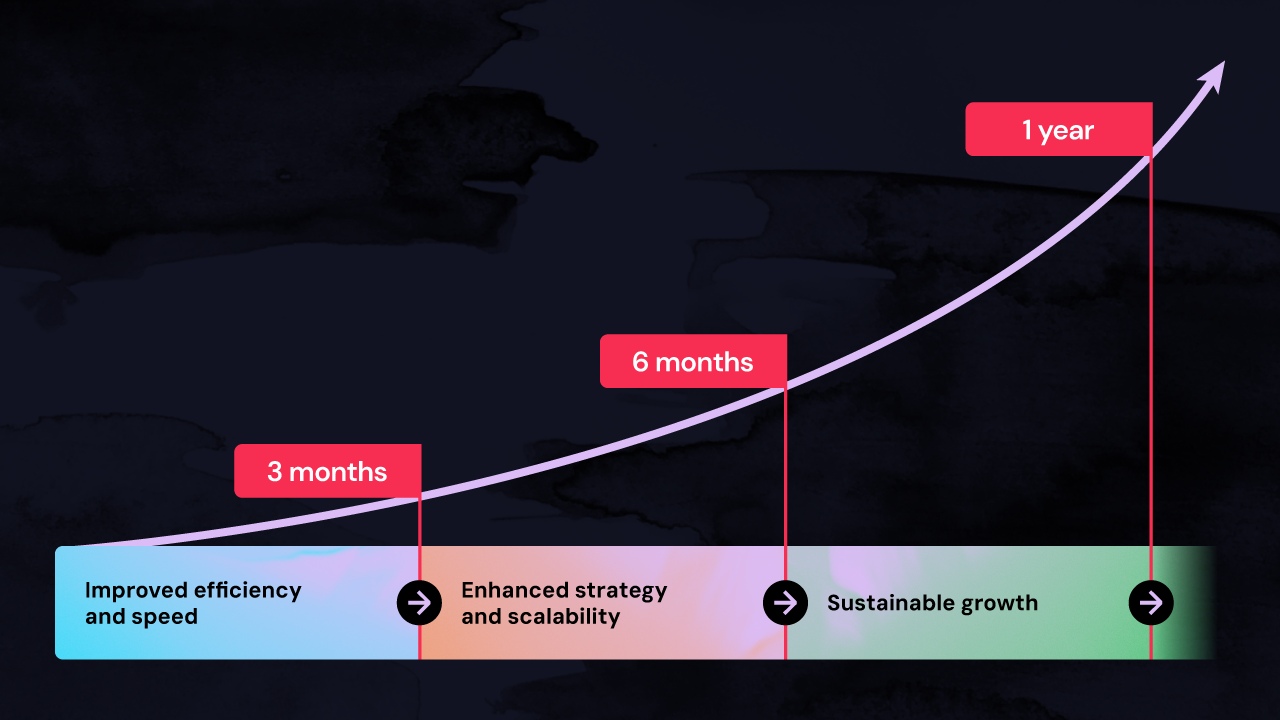It’s never been more difficult (and time-consuming) to manage multichannel digital ad campaigns. This is especially true if you still rely on single-channel operational workflows to run your campaign strategies.
A Digital Advertising Operating System (DAOS) changes everything. By unifying data, tools, and processes into one system, a DAOS simplifies workflows, enables automated AdOps execution, and gives teams cross-channel AI recommendations. In this guide, we’ll break down what a DAOS is, how it works, its key benefits, and why it’s a must-have for modern advertising teams.
What is a Digital Advertising Operating System (DAOS)?
A Digital Advertising Operating System is a software infrastructure that uses automation and data integration to connect the people, process, systems, and tools needed to execute and manage ad campaigns across channels.
Think of a DAOS like your computer’s operating system (OS). An OS manages all the different programs and hardware on your computer so they can work together seamlessly.
A DAOS does the same for your advertising operations. A DAOS brings together everything that goes into building, managing, and reporting multichannel ad campaigns, making it possible to perform these functions in one system.
In many ways, a DAOS is the foundational tech layer that your entire advertising operations run on. It gives your teams a single source of truth for every ad campaign within your portfolio, even across multiple channels. It does this by connecting your data sources (e.g., CRM, inventory feeds), your people (e.g., ad strategists, analysts), your processes (e.g., budgeting, reporting, and more), and your advertising publishers (Google, Meta, etc.) into one unified place.
How does a Digital Advertising Operating System (DAOS) work?
A Digital Advertising Operating System is the central hub for your advertising operations. It connects people, processes, and tools to enable scalable, automated, data-powered campaigns across major ad channels. By unifying vital campaign components into one system, a DAOS simplifies every core AdOps workflow. This means teams can manage consistent, high-performing campaigns with far less time and effort.
Here’s a quick rundown on how a Digital Advertising System works to make this possible:
- Ingests data from multiple ad publishers, first-party data sources, and more: A DAOS can pull data from key sources, including CRMs, product catalogs, and spreadsheets. Most importantly, a DAOS can pull and push data to major ad publishers, too. This means you can update multichannel campaigns from within the system without logging into individual platforms to launch or modify ads.
- Centralizes campaign strategies and playbooks: Think of the DAOS as the "hub" for all your ad channel strategy "spokes." You can codify the unique campaign strategies, rules, and playbooks for every account/client into the system. This could be campaign structures for different client verticals (e.g., automotive, real estate) or specific budget pacing strategies. Codifying these elements ensures that AI and automation adhere to strict campaign requirements when executing tasks or making recommendations across all your advertising channels.
- Automates multichannel campaign execution from one place: Once your campaign rules, budgets, and creative assets are synced in the DAOS, automation handles the heavy lifting. You can build, launch, and manage multichannel campaigns in one place using automated workflows. Automation ensures consistency and precision across major ad publishers, decreasing task work by 60% so teams can focus on strategic efforts.
- Unifies multichannel campaign management: With a DAOS, your team interacts with one interface—not multiple—to make changes, monitor performance, and manage budgets across your entire portfolio. This is a huge time-saver whether you’re managing 50 accounts or 50,000 accounts across major ad channels.
- Enables and automates clear-cut reporting: Because a DAOS unifies data from all channels into one platform, it eliminates the complexity and manual effort that goes into creating cross-channel reports. Teams can use a DAOS to automate report creation, scheduling, and delivery for every account in your portfolio. Reporting is no longer a time-consuming administrative burden, but rather a fuel source for data-powered decision-making.
- Embeds AI agents to scale your team's capabilities: Specialized AI, like Muse, is integrated directly within a DAOS. With full access to unique client goals, brand requirements, and multichannel data, AI can generate compliant copy, analyze cross-channel performance, and make optimization recommendations for your entire portfolio. This makes AI a true digital teammate for your AdOps teams, not a one-off add-on.
How is using a Digital Advertising Operating System (DAOS) different from the advertising tools I use today?
The fundamental difference between traditional AdOps tools and a Digital Advertising Operating System (DAOS) is that a DAOS doesn’t rely on campaign-specific workflow silos because it acts as a single, integrated operational engine.
Most third-party advertising tools solve specific, isolated AdOps problems, such as reporting or bid management on a single channel. Unfortunately, this approach forces teams to repeat the same core functions (budgeting, optimizing, reporting, etc.) for every channel, campaign, or client. As a result, it’s impossible to break free of the complexity and tedium accompanying the demands of multichannel campaign management.
Additionally, these traditional tools layer into your existing tech stack to address a specific workflow. That means they fail to address the fundamental fragmentation issues, like technical debt and manual handoffs, that actually slow down your ad teams.
A Digital Advertising Operating System (DAOS) centers entirely on data activation to break down the operational bottlenecks getting in the way of AdOps efficiency. It builds the “data pipes” that connect all the technologies and channels you need to efficiently run multichannel campaigns at scale. This fundamental shift replaces redundant tech, merges complex processes into cross-channel workstreams, and enables scalable execution and cross-channel insights that traditional tools simply can't provide.
For example, your AdOps today likely rely on human teams to manage and manually stitch together campaigns from disparate data sets. Essentially, your people are a (very expensive) “glue” that puts together multichannel campaigns. A DAOS replaces this entire way of working by integrating all your data into one place so you can automatically power campaigns directly from your data sources.
Centralizing everything—data, tools, and strategy—into one system means teams can manage multichannel campaigns holistically, finally breaking free of the traditional ways of working that prevent scale. Instead, your ad strategists can focus on true omnichannel campaign management and strengthening client relationships: two things that they excel at doing.
Key benefits of using a Digital Advertising Operating System (DAOS)
- Unlocking true AdOps scalability: This is the biggest win for advertising teams. Using multichannel automation rules within a DAOS means you can launch one campaign or a thousand with the same amount of effort. It can execute a high volume of AdOps tasks without taxing your human teams, making it possible to decouple portfolio growth and employee headcount. Our latest client data shows that a typical ad strategist can handle two to four times (2-4x) more accounts with a DAOS than they could previously.
- Operational speed and agility: With everything living in one place, teams can take immediate action for core AdOps tasks across multiple channels at one time: copy changes, new campaign launches, keyword adjustments, etc. Integrated AI tools make analyzing and activating real-time performance insights from major ad channels even easier. Some tasks, like budget pacing, can be completely managed by automation. As one of our agency clients said, “We’ve automated the whole [budget pacing] process and don’t have to really do anything. We just make sure that the numbers are correct and Fluency allocates the budget the way we need it to.”
- Strategic brand control: Centralized management in the Digital Advertising Operating System (DAOS) reinforces total governance across your entire portfolio. By codifying regulatory requirements and client-specific needs within the DAOS, you can ensure brand safety, compliance, and strategic alignment across thousands of localized campaigns.
- Eliminating risk: Since automation always performs tasks exactly as instructed, automating repetitive AdOps tasks virtually eliminates human error. This means no expensive rework or costly mistakes that drive up client credits.
- Improving campaign performance: Simply put, the combined benefits of automation and holistic data management lead to better campaign performance results. True cross-channel management gives you more control over unified goals and KPIs. It also enables you to reduce errors, accelerate campaign launches, and maximize budget spend.
- Future-proofing with AI operability: The foundation of a DAOS—integrating all your advertising channels and data into one system—is a critical step if you want to maximize AI capabilities. A centralized data architecture lays the cross-channel foundation that’s required for sophisticated AI tools (like Muse) to find the little gold nuggets you need to move the needle.
- Streamlining and simplifying agency-client collaboration: A DAOS provides a single "pane of glass" for you to jointly collaborate on with your clients. Whether it’s onboarding, media asset uploads, or budget or geo-targeting adjustments, you can give clients clear visibility into what you’re doing and why. A DAOS also centralizes client requests and approvals, reducing manual handoffs (and a ton of emails) by automatically integrating any changes right into campaigns—even if they’re already live.
- Empowering your people to do their best, most enjoyable work: A DAOS automates the time-consuming, tedious work that burns people out. It frees your team to focus on what they do best: strategy, client relationships, and creative thinking. Not only does this reduce the need to hire every time you bring in more clients, but it can also improve talent retention for your current team. When people can do more meaningful, high-impact work, they’re far less likely to leave.
The unified, automated, and AI-powered future of advertising
Ask anyone working “on the ground” in digital advertising: daily campaign operations have become far too complex to manage effectively with manual processes and fragmented workflows. A Digital Advertising Operating System (DAOS) solves this problem at the roots by unifying data, people, processes, and publishers into a single, automated infrastructure.
Simply put, a DAOS provides advertisers with scalability, speed, and control that individual tools can’t. It enables advertisers to execute localized, data-powered campaigns at scale while also providing real-time insights that inform strategic decision-making.
By reducing inefficiencies and eliminating silos, a DAOS transforms how advertising teams operate, delivering better results with less effort. Read some case studies to see what top advertisers have achieved by unifying their advertising operations.






